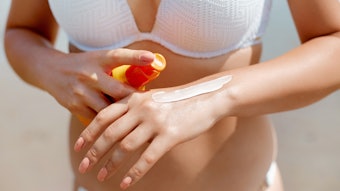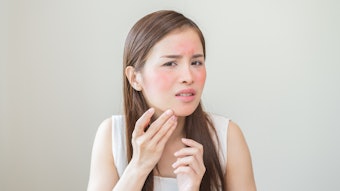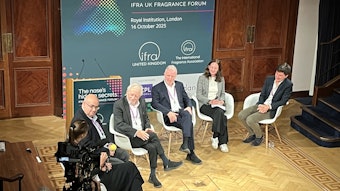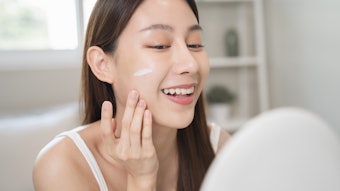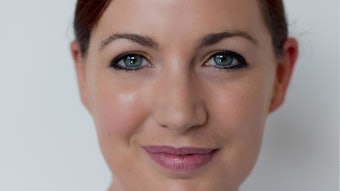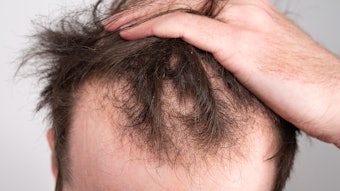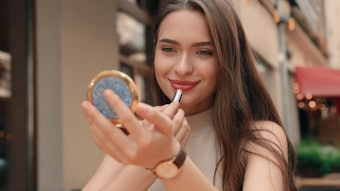Skin Care
Anti-acne cosmetics: In a recent review, Akaza reports that sodium dl-α-tocopheryl phosphate (VEP) controls the predominant type Propionibacterium acnes in acne vulgaris.1 P. acnes is thought to be one of the most important factors involved in the pathogenesis of acne vulgaris. Various kinds of vitamin preparations are widely used as adjuvants in the clinical treatment of acne vulgaris; however, the mechanisms of the therapeutic actions of these vitamins have not yet been clarified. Therefore, Akaza studied the antimicrobial activities of vitamins B2, B6, C, E and their derivatives against P. acnes in the clinical treatment of acne vulgaris.
VEP showed the strongest antimicrobial activity against P. acnes. In particular, the antimicrobial activity of VEP was more effective against P. acnes DNA-type 3. Of all the various DNA-types of P. acnes, DNA-type 3 is considered to have the most influence on the pathogenesis of acne vulgaris. The mechanism of the antimicrobial activity of VEP against P. acnes was via destruction of the cell membrane, the same mechanism used by surfactants. Using lotions containing VEP for four weeks reduced the number of P. acnes lesions and also reduced indications of inflammatory acne vulgaris. These results suggest that anti-acne cosmetics containing VEP are effective for reducing and preventing acne vulgaris.
Skin care for pores: Nishijima has published on skin care for pores.2 Troubles with facial pores, such as excess sebum secretion or conspicuousness of pores, are a concern for many women. In this paper, the author describes the relationship between conspicuousness and structures about the pores on the cheek.
Conspicuous pores on the cheek have a hollow area around openings of the follicles. With aging, the hollow area increases in size. Nishijima observed the hollow area around openings of the follicles non-invasively by using an in vivo confocal microscopic technique. Around the follicles was a peculiar epidermal structure that was described as thick epidermis and numerous elongated ridges.
Seeking to improve the structure by contracting the epidermal cells, Nishijima developed a phosphorylated glyceryl ether, which has a biological function similar to that of lysophosphatidic acid and sphingosine-1-phosphate. Phosphorylated glyceryl ether altered the epidermal structure and decreased the hollow area around the pores on the cheek.
Sarsasapogenin for the figure: Sederma discloses a composition comprising sarsasapogenin for improving skin.3 The composition is said to improve the general state of the skin and in particular to improve and/or embellish any part of the body showing a deficit in lipids.
More particularly, the invention is directed to a cosmetic method to improve the figure. The method calls for topically applying a cosmetic or dermopharmaceutical composition containing sarsasapogenin to favor the expansion and/or the formation of the adipose tissue, and/or to favor the lipid synthesis in the epidermis. A plumping face gel is described that contains sarsasapogenin dissolved in hydrogenated polyisobutene, with other ingredients. Biological data are presented showing that the product activates adipocyte differentiation, stimulates lipid uptake by activation of the glucose/fructose pathway, promotes formation of lipid vesicles via adipophilin, and strengthens the installation of fat in the extracellular matrix.
Skin/Hair Pigmentation
Yeast for melanin synthesis: A patent assigned to the Societe D’Extraction Des Principes Actifs discloses the use of a yeast extract as active agent for increasing melanin synthesis in melanocytes of the epidermis or the hair bulb.4 The yeast extract consists mainly of compounds of protein and peptide nature and is obtained from yeast of the genus Saccharomyces or the genus Kluyveromyces.
The patent discloses use of the extract in cosmetic or pharmaceutical compositions. For example, Saccharomyces cerviseae extract was prepared containing 30–70% proteins and incorporated in the cosmetic gel in Formula 1.
Hair and Hair Care
Promoting hair growth: Matsuda has published a review on the search for hair growth-promoting crude drugs from natural resources.5 The author performed a literature search on classical Chinese herbal and medical books and recent Chinese medical and pharmaceutical journals. Based on that search, the author selected several crude drugs that have been used for the treatment of alopecia, thermal burn, benign prostatic hyperplasia, tonics, and dandruff prevention. Testosterone 5-α-reductase inhibitory activity of the selected crude drugs and other randomly selected crude drugs was assayed to find novel hair growth-promoting agents.
In testosterone-treated C57Black/ 6CrSlc mice, the hydro/alcoholic extracts of Myricae Cortex (bark of Myrica rubra) and Lygodii Spora (spore of Lygodium japonicum) showed in vitro 5-α-reductase inhibitory activity, in vivo antiandrogenic activity using growth of flank organ in castrated Syrian hamsters, and hair regrowth activity after shaving. Myricanone, myricanol and myricetin were identified as the main active constituents of Myricae Cortex. From Lygodii Spora, oleic, linoleic and palmitic acids were identified as the main active constituents.
Among several Piper plant extracts, P. nigrum leaf extract showed melanogenesis stimulation activity in murine B16 melanoma cells, 5α-reductase inhibitory activity and in vivo antiandrogenic activity in testosterone-treated C57Black/6CrSlc mice. Thus, P. nigrum leaf extract and its active constituent, (–)-cubebin, may be desirable ingredients of hair care cosmetics for prevention of gray hair and alopecia.
Hinokitiol for hair growth: Kim et al. report on after-rinsing hair growth promotion by hinokitiol-containing vesicles and emulsions.6 The authors prepared two kinds of topical dosage forms of hinokitiol (HKL), namely vesicles and o/w emulsions. Behenyl trimethylammonium chloride and fatty acids were used as bilayer-forming materials of the vesicles, and oils were employed as oil phases of the emulsions.
The substantivity of HKL in the preparations was evaluated in vitro using hairless mouse skins. After applying the preparations onto the skin and rinsing it, the amount of HKL left on the skin was determined using high performance liquid chromatography (HPLC).
The amount of HKL remaining was higher when HKL was encapsulated in cationic vesicles than when it was encapsulated in nonionic emulsion vehicles. An ionic interaction between the cationic vehicle and negatively charged skin is likely to account for the high substantivity.
Among the emulsion preparations, an emulsion having octyl salicylate as oil phase exhibited the highest substantivity of HKL. This is probably because the oil is a good solvent for HKL and it is skin-retentive.
In vivo hair growth promotion effect of each dosage form was investigated. Daily for 30 days, the sample was applied onto the clipped backs of female mice (C57BL6), after which the backs were rinsed. Only HKL in the cationic vesicles had a hair growth-promotion effect, possibly due to the significant substantivity.
Acidic hair dye compositions: Hoyu Co., Ltd., discloses storage-stable acidic hair dye compositions containing acidic dyes, hydrophilic organic solvents, lipophilic hair penetrating agents, and acryloyldimethyltaurine salt copolymer thickeners.7 The thickeners may be hydroxyethyl acrylate/acryloyldimethyltaurine salt copolymer and/or sodium acrylate/acryloyldimethyltaurine salt copolymer.
An example of an acidic hair dye is shown in Formula 2. The product showed good hair-dyeing performance, good hand feel, and no separation or aggregation after storage for one month at 40°C.
Direct hair dye compositions: L’Oréal discloses a hair dye composition containing a direct dye and an amphoteric polymer comprising acrylamide, dialkyldiallylammonium halide and vinyl carboxylic acid units.8 An example of the hair dye claimed is shown in Formula 3.
Makeup
Ascorbyl compounds and hydrogenated lecithin: Beiersdorf AG discloses the use of combinations of ascorbyl compounds and hydrogenated lecithin as active ingredients in cosmetic skin preparations.9 The ascorbyl compounds are ascorbic acid and its derivatives. The hydrogenated lecithin is delivered with palmitic acid and mixtures of C12-C16. An example of an o/w foundation lotion is shown in Formula 4.
Polyols, oils and waxes: Beiersdorf AG also discloses a particular combination of polyols, light oils, medium heavy oils and waxes for foundations and other cosmetic skin preparations.10 The light oils have viscosities of 1–15 mPas and spreading values of 800–1200 mm2/10 min. The medium heavy oils have viscosities of 20–100 mPas and spreading values of 300–600 mm2/10 min. The waxes have a melting point in the range of 25–45°C. The total amount of light oils is less than the total amount of medium heavy oils and waxes. An example is shown in Formula 5.
Polysiloxane-treated powders and coated silicone elastomers: A Shiseido Co. patent discloses powdery cosmetics containing 3–80% by weight of polysiloxane-treated powders and 1–30% by weight of powders coated with silicone elastomers.11 The polysiloxane is a branched alkylsilicone. The silicone elastomer powder is a composite wherein the powder surface is entirely or partly coated with at least one material selected from: a clay mineral, resin, metal oxide and a salt. The patent describes powdery cosmetics with slipperiness, smoothness, satisfactory use performance, stickiness to the skin, and resistance against makeup deterioration. An example of this type of powder foundation is shown in Formula 6.
Sunscreens
Universal SPF by noninvasive method: Weigmann et al. propose a universal sun protection factor based on ex vivo spectroscopic quantification of sunscreen efficacy.12 The sun protection factor (SPF) describes the protective behavior of sunscreens insufficiently, because this factor takes into account only the UVB spectral range, and strains the volunteers during its determination by invasively invoking an erythema.
The authors propose a new noninvasive method based on the UV spectroscopic measurement of tape strips taken from a sunscreen-treated skin area. The resulting sum transmission spectra of the tape strips reflect the in vivo distribution of the absorber on the skin and quantify the protective efficacy of the applied sunscreens over the complete UV spectral range.
The spectroscopic data provide a basis for the calculation of a universal sun protection factor (USPF). The comparison of the concrete values of USPF and SPF results in the following statements:
• A unique functional correlation is not to be expected because UVB and UVB dependence are different.
• The amount of difference between the USPF values and the SPF values is influenced clearly by the intensity relation of the average sum transmission in the UVB range compared to the UVA range.
• The USPF values objectively assess the efficacy of sunscreens considering protection against all irradiation injuries.
Suntanning with (2-hydroxyethyl) urea: Beiersdorf AG discloses suntanning compositions containing (2-hydroxyethyl) urea as the active ingredient.13 These compositions also contain 1,3-dihydroxyacetone, and to increase stability during storage, they contain one or more compounds selected from the group of tocopheryl acetate, phenoxyethanol, ethyl hexyl glycerol, 2-methylpropane-1,3-diol, butylene glycol, 1,2-hexanediol, 1,2-octanediol and 1,2-decanediol. The composition of a sprayable o/w emulsion is shown in Formula 7.
Sunscreening with (2-hydroxyethyl) urea: A patent issued to Beiersdorf AG discloses cosmetic preparations with (2-hydroxyethyl) urea and myristyl myristate.13 According to the patent, gels, emulsions and dispersions can also contain emulsifiers, sunscreens and skin cosmetic substances. The composition of a sunscreen gel is shown in Formula 8.
Interesting New Ingredients and Formulations
Ester blends: ISP Investments Inc. discloses ester blends for improved solubilization of active and functional organic compounds.15 One part of the blend is the reaction product of an aryl alcohol and an alkyl or aryl carboxylic acid. The other part is the reaction product of a C1-C22 linear or branched, saturated or unsaturated alcohol and a hydroxy acid. The ester blend provides enhanced solubilization of active and functional organic compounds selected from a personal care active, a cosmetic active, a pharmaceutical active, an industrial active, an agricultural active and a preservative active.
In one example, 2-phenylethyl benzoatea (ester 1) dissolved 7% of ethylhexyl triazoneb and 34% of bis-ethylhexyloxyphenol methoxyphenyl triazinec, while C12-C15 alkyl lactated (ester 2) dissolved 24% of ethylhexyl triazone and 6% of bis-ethylhexyloxyphenol methoxyphenyl triazine. However, a 1:1 mixture of these two emollient esters dissolved 21% of ethylhexyl triazone and 23% of bis-ethylhexyloxyphenol methoxyphenyl triazine, in addition to 19% of avobenzone and 29% of oxybenzone.
Hair emulsions that do not wash off: Kao Corp. discloses hair cosmetic emulsions that do not wash off.16 These compositions contain acrylic acid/alkyl methacrylate copolymers or their salts as well as higher alcohols, nonionic surfactants, polyol condensate fatty acid esters and, optionally, other water-soluble thickening agents. An example of such a hair cream is shown in Formula 9. At 30°C and 5 rpm, the product had a viscosity of 50,000 mPa.s, thixotropic properties, good spreadability on skin, no sticky feeling, and no viscosity change or phase separation after storage for 30 days at 50°C.
Organic-modified clay minerals: Topical emulsions containing organic-modified clay minerals and N-acylglutamic acid esters have been disclosed by Pola Chemical Industries, Inc.17 In addition to the organic-modified clay minerals and N-C10-C30 acyl glutamic acid dialkyl esters, the emulsions may optionally contain polyether-modified methyl polysiloxanes. An example of such a w/o emulsion is shown in Formula 10.
(2-Hydroxyethyl) urea and hyaluronic acid: Beiersdorf AG discloses cosmetic formulations containing (2-hydroxyethyl) urea and hyaluronic acid in gels, emulsions and dispersions.18 Emulsifiers, sunscreen actives and skin cosmetic substances may also be included in the formulations. The composition of an o/w lotion is shown in Formula 11.
References
1. N Akaza, Sodium dl-alpha-tocopheryl phosphate controls predominant type Propionibacterium acnes in acne vulgaris, Frag J 35(5) 25–29(2007) (in Japanese)
2. T Nishijima, Skin care for pores, Nippon Koshohin Gakkaishi 31(1) 25–30 (2007) (in Japanese)
3. WO 2008 15,639, Composition comprising sarsasapogenin for improving skin, Sederma, France (Feb 7, 2008)
4. WO 2008 15,343, Use of a yeast extract as active agent for increasing melanin synthesis in melanocytes, Societe D’Extraction Des Principes Actifs SA, France (Feb 7, 2008)
5. H Matsuda, Search for hair growth promoting crude drugs from natural resources, Frag J 35(12) 41–48 (2007) (in Japanese)
6. J-C Kim et al, After-rinsing hair growth promotions of hinokitiol-containing vesicles and emulsions, J Dispersion Sci Technol 28(5) 697–701 (2007) (in English)
7. JP 2008 19,203, Storage-stable acidic hair dye compositions containing hydrophilic organic solvents, lipophilic penetrants, and acryloyldimethyltaurine salt copolymer thickeners, Hoyu Co Ltd, Japan (Jan 31, 2008)
8. EP 1,886,661, Hair dye composition containing a direct dye and an amphoteric polymer comprising acrylamide, dialkyldiallylammonium halide and vinyl carboxylic acid units, L’Oréal, France (Feb 13, 2008)
9. DE 102,006,035,040, Combinations of ascorbyl compounds and hydrogenated lecithin as active ingredients in cosmetic skin preparations, Beiersdorf AG, Germany (Jan 31, 2008)
10. DE 102,006,035,042, Cosmetic skin preparations especially foundations, Beiersdorf AG, Germany (Jan 31, 2008)
11. WO 2008 12,922, Powdery cosmetics comprising polysiloxane-treated powders and coated silicone elastomers, Shiseido Company Ltd, Japan (Jan 31, 2008)
12. H-J Weigmann et al, Ex-vivo spectroscopic quantification of sunscreen efficacy: proposal of a universal sun protection factor, J Biomedical Optics 12(4) 044013/1–044013/8 (2007) (in English)
13. DE 102,006,034,532, Suntanning agents containing (2-hydroxyethyl) urea, Beiersdorf AG, Germany (Jan 31, 2008)
14. DE 102,006,034,531, Cosmetic preparation with (2-hydroxyethyl) urea and myristyl myristate, Beiersdorf AG, Germany (Jan 31, 2008)
15. WO 2008 14,505, Ester blends for improved solubilization of active and functional organic compounds, Isp Investments Inc, USA (Jan 31, 2008)
16. JP 2008 19,216, Non-wash-off type hair cosmetic emulsions containing acrylic acid-alkyl methacrylate copolymers, higher alcohols, nonionic surfactants, and polyol condensate fatty acid esters, Kao Corp, Japan (Jan 31, 2008)
17. JP 2008 13,515, Topical emulsions containing organic-modified clay minerals N-acylglutamic acid esters, Pola Chemical Industries Inc, Japan (Jan 24, 2008)
18. DE 102,006,034,529, Cosmetic formulations containing (2-hydroxyethyl) urea and hyaluronic acid, Beiersdorf AG, Germany (Jan 31, 2008)
